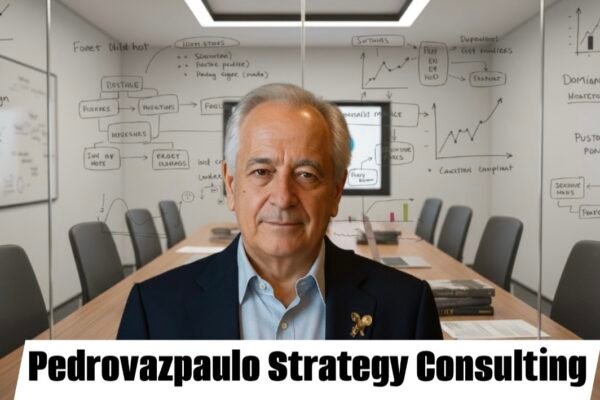Pedrovazpaulo Stocks Investment: Smart Moves for Growth

Pedrovazpaulo stocks investment refers to applying the Pedrovazpaulo firm’s strategies and methods to pick, manage, and optimize stock holdings for medium- to long-term growth. With a structured process of research, diversification, risk management, and periodic review, it aims to deliver above-market returns while controlling downside exposure.
In this article, we unpack the concept of pedrovazpaulo stocks investment what it means, how the firm’s philosophy influences stock selection, and how investors can adopt those principles. You’ll read about strategy, risk, tools, portfolio construction, performance evaluation, and pitfalls. Whether you’re a beginner or seasoned investor, this guide gives actionable insights and a structured approach to applying the Pedrovazpaulo method to stock investing—with clarity, balance, and real-world relevance.
Table of Contents
ToggleUnderstanding Pedrovazpaulo’s Philosophy in Stock Investing
Pedrovazpaulo presents itself as a full-service wealth and investment consultancy that integrates strategic planning, tax efficiency, risk mitigation, and tailored guidance. heir stock investing philosophy is rooted in combining data-driven fundamentals with long-term vision: seeking undervalued equities, staying diversified, and adjusting as markets change. he idea is not to chase speculative fads but to build resilient portfolios that weather volatility.
This philosophy also ties closely to their wealth planning, estate structuring, and tax optimization practices. In a world where short-term trading often dominates headlines, Pedrovazpaulo emphasizes discipline, patience, and evidence-based decision making. Their methodology sees stock investment as an integral part of multi-asset wealth growth—not a standalone gamble. To apply this in practice, you’ll need a framework: from stock screening to evaluation, allocation, monitoring, and exit rules. In the sections ahead, we break down each step so you can adapt their approach to your portfolio.
The Role of Stocks in a Pedrovazpaulo Portfolio
In the Pedrovazpaulo wealth investment model, stocks are one of multiple pillars—alongside real estate, alternative assets, fixed income, and tax-sensitive vehicles. Stocks serve as the engine for capital appreciation and growth potential, especially over long horizons. That said, they are balanced by stabilizing assets to reduce drawdowns. The firm’s guidance suggests that a core equity allocation might range from 40 % to 70 % depending on risk tolerance, age, and goals.
Within stocks, they advocate sector diversification (technology, healthcare, consumer, industrial, energy) plus geographical spread, so the portfolio is not overexposed to one region’s macro cycles. Dividend-paying stocks, or stocks with predictable cash flows, often play a stabilizing role in their model. For many investors, applying Pedrovazpaulo’s paradigm means setting stocks as the growth core, then layering in other assets to moderate volatility and improve risk-adjusted returns.
Stock Selection: Research & Fundamental Analysis
At the heart of pedrovazpaulo stocks investment is rigorous stock selection. The process begins with filtering and screening. Use quantitative metrics like P/E, P/B ratio, debt/equity, return on equity (ROE), and free cash flow. Then layer qualitative assessment: management quality, competitive moats, pricing power, and macro trends. The Pedrovazpaulo model often emphasizes undervalued or underappreciated firms with strong fundamentals. They also recommend a “margin of safety” buffer so you avoid overpaying for expectations. In practice, it means buying with a discount to your estimated intrinsic value. Over time, they advocate holding for several years, letting compound growth work. Another hallmark is continuous monitoring and re-evaluation—if fundamentals deteriorate, it’s a signal to exit or reduce positions.
Key steps:
- Screen quantitatively
- Qualitative analysis (management, industry)
- Estimate intrinsic value
- Compare to market price, apply margin of safety
- Monitor periodically
This disciplined process helps reduce emotional mistakes and aligns with long-term orientations.
Portfolio Construction & Allocation Rules
Once individual stocks are vetted, the Pedrovazpaulo method turns to how many and how much to allocate to each. They often adopt a “core + satellite” model: a stable core of reliable equities and smaller satellite allocations to growth or tactical picks. The core might represent 60–80 % of equity holdings, while the rest are more aggressive or opportunistic picks.
They also advise maximum single-stock position limits (e.g. 5–10 %) to avoid catastrophic underperformance from one failure. Sector exposure caps are also recommended—no more than, say, 25 % in any one sector unless conviction is very high. Global exposure is another balancing component: mixing developed and emerging markets to capture growth without being overly exposed to one economy. Over time, rebalancing ensures the portfolio stays aligned with target weights. The result is a diversified yet purposeful equity portfolio.
Risk Management: Mitigating Downside
Pedrovazpaulo’s approach to stocks investment emphasizes downside protection as much as upside. They recognize markets are volatile and that preserving capital is equally critical. Tools and methods include stop-loss or trailing stop rules, hedging via options (for advanced portfolios), and holding cash cushions for volatility. They also stress diversifying across sectors, geographies, and styles (value, growth, dividend).
Another technique is stress-testing the portfolio under various macro scenarios (recession, inflation shock, rate hikes) and reviewing how much each stock might fall. If a single holding threatens to drag the portfolio too much, trimming or exit is warranted. Regular reviews—quarterly or semiannual—help ensure that the portfolio remains within tolerable risk limits. By treating stock investing with risk controls built in, Pedrovazpaulo reduces the chances that a sharp downturn devastates their clients’ wealth.
Monitoring, Review & Rebalancing
No portfolio is “set and forget.” In the pedrovazpaulo stocks investment framework, periodic monitoring and rebalancing are essential. They propose scheduled check-ins—say quarterly—to track performance deviations, valuation changes, and macro shifts. If a stock’s weight grows too high (due to outperformance), trimming helps maintain balance. Conversely, underweight positions may be increased if fundamentals remain strong.
Additionally, they examine earnings reports, management changes, industry disruption, and economic updates. If a company’s fundamentals deteriorate materially, they may remove it entirely. Rebalancing ensures the portfolio stays close to target allocations, avoids drift, and locks in gains. This disciplined maintenance helps sustain performance while reducing risk of concentration or value traps.
Tax Efficiency & Structural Considerations
One often overlooked layer in pedrovazpaulo stocks investment is tax planning. Since PedroVazPaulo is fundamentally a wealth management firm, it integrates structures to optimize tax outcomes. For instance, holding stocks in tax-favored accounts, using tax-loss harvesting (selling losers to offset gains), and shifting dividends or capital gains across tax years are strategies they employ. They also consider the jurisdictional tax rules (local vs cross-border investing). Structurally, they may use trust vehicles or holding companies to reduce tax drag. The idea is that every incremental tax saved boosts net returns—and over time, compounding after-tax returns matter more than gross returns.
Tools, Software & Data Inputs
To implement pedrovazpaulo stocks investment effectively, you need robust tools. They often rely on financial data platforms (e.g. Bloomberg, FactSet, Morningstar) for up-to-date fundamentals and valuations. Charting and technical overlay tools help identify trend shifts. They also integrate macro indicators (interest rates, inflation, GDP forecasts) into scenario analyses.
Another layer is algorithmic screening and alerts—custom filters to flag valuation changes, news events, and insider activity. Many clients might use portfolio tracking dashboards, risk analytics (Value at Risk, downside beta), and performance attribution modules. For retail investors, less sophisticated but still solid options like Yahoo Finance, Seeking Alpha, or Value Line can serve essential functions. The key is creating a workflow where data informs decisions, not guesses.
Performance Measurement & Benchmarking
How do you know whether your pedrovazpaulo stocks investment is working? You need measurement. First, choose an appropriate benchmark or blend (e.g. S&P 500, MSCI World, or sector indices). The portfolio’s return above or below that benchmark is the relative performance. Next, risk-adjust metrics matter: Sharpe ratio, Sortino ratio, and maximum drawdown help contextualize returns relative to volatility.
At Pedrovazpaulo, they also compute attribution: which stocks or sectors drove returns, and where mistakes occurred. Over time, time-weighted returns and compound annual growth rate (CAGR) are tracked. If performance persistently lags benchmarks after adjusting for risk and costs, it signals rethinking the strategy. Transparent performance review is part of their client relationship model.
Behavioral & Emotional Discipline
Even the best model fails if the investor misbehaves. Pedrovazpaulo emphasizes emotional discipline. They counsel against chasing hot tips, panic selling in downturns, or overtrading. Instead, investors should stick to their plan, rein in greed or fear, and avoid impulsive moves.
One technique is pre-committing to rules (e.g. rebalancing only at set intervals, capping exposure). Keeping a journal of buy/sell rationale helps monitor emotional bias. Regular reflection helps you learn from mistakes. In their client engagements, the advisory team often acts as a check on emotional impulses. In sum, the human side—staying level-headed—makes or breaks even the best stock-selection system.
Common Pitfalls & How to Avoid Them
To practice pedrovazpaulo stocks investment successfully, you must guard against pitfalls:
- Overconcentration (putting too much in a single name)
- Ignoring macro risks or valuation extremes
- Failing to rebalance, letting winners dominate
- Chasing momentum or “hot” stocks at peak
By building rules (max position sizes, stop rules, periodic reviews), these pitfalls become manageable. Another common error is neglecting costs—commissions, taxes, bid-ask spreads—eroding returns. Also, failing to adapt: markets evolve, and a static approach fails over time. Regular strategy review, flexibility, and humility are essential defenses.
Applying This Model to Emerging Market Stocks
Many investors are curious whether pedrovazpaulo stocks investment can work in emerging markets. Yes—with caveats. Emerging markets often offer high growth but come with greater volatility, governance risk, currency risk, and regulatory uncertainty. The selection process must be more stringent: deeper due diligence, local insight, and risk buffers.
In emerging markets, diversify across countries, avoid overly concentrated exposure, and use smaller position sizes. Monitor macro instability, political risk, and currency moves. Use hedging when possible. Because valuations can be more volatile, margin-of-safety buffers should be more conservative. When applied carefully, the same principles—diversification, valuation discipline, risk control—can still produce excess returns in emerging environments.
Integrating Stocks with Other Asset Classes
In pedrovazpaulo stocks investment, equities are one leg of the stool. To build robust portfolios, they integrate:
- Fixed income: bonds, treasuries, corporate debt, to stabilize returns
- Real estate / property: as a hedge to inflation and portfolio diversifier
- Alternative assets: private equity, commodities, hedge funds
- Cash/Short-term instruments: for liquidity and tactical flexibility
The idea is that while stocks drive growth, the other classes absorb shocks and provide balance. Allocation among these depends on investor age, risk tolerance, goals, and market outlook. Periodic rebalancing across all assets helps maintain the intended risk profile.
Real-World Case: Hypothetical Pedrovazpaulo Stock Portfolio
Let’s imagine a model pedrovazpaulo stocks investment portfolio for a moderately aggressive investor with a five-year horizon:
- Core (60 % of equities):
• 15 % in stable dividend blue chips
• 15 % in large-cap growth tech
• 10 % in consumer staples
• 10 % in healthcare
• 10 % in industrials - Satellite (the remaining 40 %):
• 10 % in emerging market equities
• 10 % in small-cap growth picks
• 10 % in green / ESG-focused stocks
• 10 % in tactical sector bets (e.g. AI, robotics)
Strict caps: no single name > 7 %, no sector > 25 %. Rebalance quarterly. Use stop-loss at −15 %. Use tax-loss harvesting annually. Monitor macro shifts. Over five years, evaluate performance vs benchmark, adjust for overrated holdings, and rotate into undervalued areas when opportunities appear. This illustrative portfolio follows the Pedrovazpaulo philosophy: diversified, disciplined, growth-oriented, with risk controls.
How to Get Started & Steps to Implement
If you want to adopt pedrovazpaulo stocks investment in your own portfolio, here’s a roadmap:
- Define your goals, timeline, and risk tolerance
- Choose a suitable equity allocation within your total portfolio
- Build a screening and stock selection process
- Limit individual and sector exposure
- Monitor, review, and rebalance regularly
- Incorporate tax strategies
- Use data tools and maintain discipline
- Track and benchmark performance
- Reflect on behavioral biases
- Iterate and evolve your model
Start modestly — maybe with a few positions. Over time, scale as you gain confidence in the system. Engage with mentors, read financial statements carefully, and remain humble in face of market surprises.
Conclusion
The term pedrovazpaulo stocks investment embodies a disciplined, research-based, and long-term approach to equity investing, embedded within a broader wealth planning framework. It combines rigorous screening, diversification, risk control, tax-aware structuring, and behavioral discipline. While no method guarantees profits, the strength of this approach lies in its coherence and adaptability. Whether in developed or emerging markets, by tailoring the principles to your circumstances—as shown in the model portfolio and step-by-step path—you can build a resilient equity strategy. Done well, it becomes a dependable engine for long-term wealth creation.
FAQs
Q1: Is pedrovazpaulo stocks investment suitable for beginners?
Yes — its structured, rule-based approach helps beginners avoid emotional mistakes. Start small, follow the framework, and gradually scale.
Q2: How many stocks should I hold under this strategy?
Generally, 15 to 25 stocks is reasonable—enough to diversify, yet manageable for monitoring.
Q3: How often should I rebalance?
Quarterly rebalancing is typical, though semiannual is also acceptable depending on trading costs.
Q4: What should I do when a stock’s fundamentals change adversely?
Trim or exit the position. One of the hallmarks is to react when fundamentals deteriorate, not cling to losers.
Q5: Can I apply this in different countries’ markets?
Yes — but adjust for local risks (currency, regulations) and use more conservative valuation buffers in emerging markets.
You may also like


PedrovazPaulo Executive Coaching Unleashed

Leave a Reply